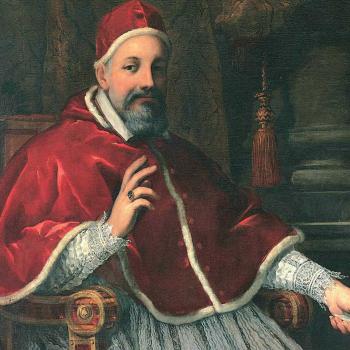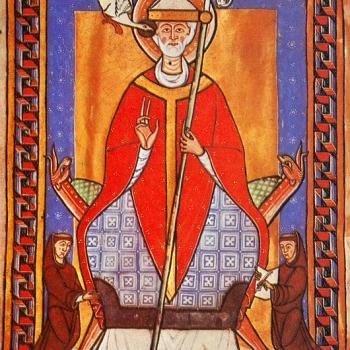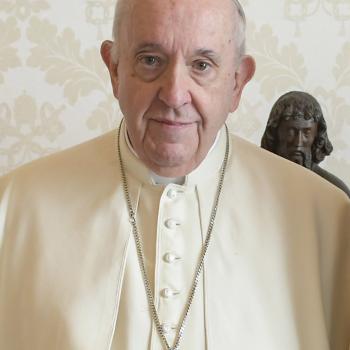 Today we are so pleased to welcome a guest post by Verónica Gutiérrez, associate professor of Latin American History at Azusa Pacific University and Director of Undergraduate Research.
Today we are so pleased to welcome a guest post by Verónica Gutiérrez, associate professor of Latin American History at Azusa Pacific University and Director of Undergraduate Research.
Earlier this week, on October 4, we celebrated the feast of St. Francis of Assisi according to the General Roman Calendar of the Catholic Church. Traditionally, on or around this day, Catholic, Episcopalian, Methodist, Lutheran, and other Christian churches across the United States invite parishioners to bring in their pets for a blessing. So strong is the association of St. Francis with animals that he transcends Christianity, appealing to environmentalists, ecologists, and animal lovers without religious affiliation. Not only does the Humane Society of the United States dedicate a full page to St. Francis on their website, but also, many countries across the globe celebrate World Animal Day on October 4.
I spent an October 4 in Mexico one year, and my experience was markedly different. I was staying in a Franciscan guesthouse, formerly a small friary, in the Franciscan stronghold of Cholula in the central Mexican state of Puebla. I had a simple little room in the back, a recent add-on to the colonial-era convento, which opened up to a back patio with grassy hillocks over which hopped adorable baby bunnies and their mothers. Along the back wall, pens contained peacocks, chickens, and some caged hamsters, all guarded over by a large dog named King. My initial reaction when I moved in was to think how very Franciscan it all was.
Early on October 4, the pop pop pop of cohetes startled me awake. As I sat up, I noted the deep tones of brass instruments outside the wall of my room that abutted the street, signaling the passing of a marching band. I had been living in Cholula for several weeks on a research trip and firecrackers and marching bands had become a near daily experience. The Cholulteca, a Mexican roommate from Veracruz had explained rather dismissively, were prone to festivity.
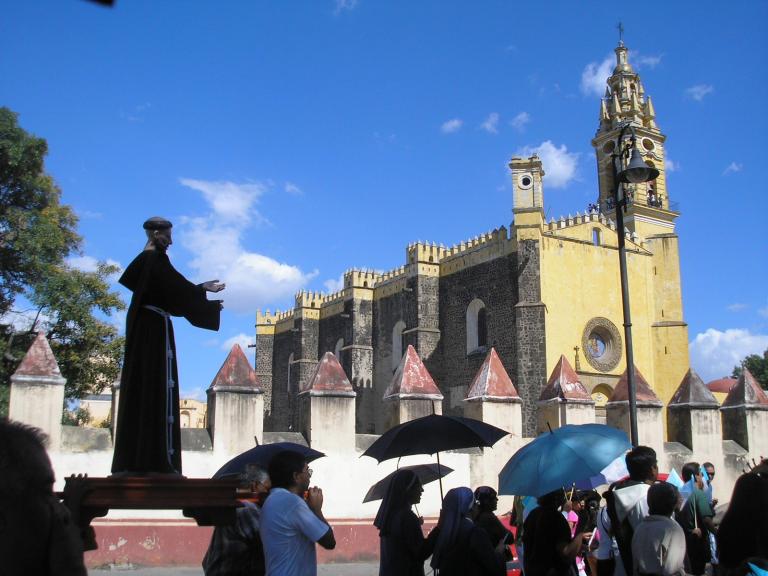 Dressing quickly, I caught the crowd as it turned the corner onto my street and together we processed through the gates of the colonial evangelization complex and into the imposing Church of San Gabriel adjacent to Cholula’s main Franciscan friary. Completed in 1552, native Cholulteca had enthusiastically built the church using stones from the former Quetzalcoatl Sanctuary, viewing it, as the late James Lockhart argued, as an analogue to the pre-conquest temple. Pausing inside before a statue of St. Francis on a flower-laden table, the band played Las Mañanitas, a traditional morning greeting for one’s saint day/birthday (in Mexican culture this is often the same day). After the friars said Mass in honor of their patron, the ladies of the church distributed a meal. Aside from the stray dogs roaming through town, there were no animals involved in the day’s festivities.
Dressing quickly, I caught the crowd as it turned the corner onto my street and together we processed through the gates of the colonial evangelization complex and into the imposing Church of San Gabriel adjacent to Cholula’s main Franciscan friary. Completed in 1552, native Cholulteca had enthusiastically built the church using stones from the former Quetzalcoatl Sanctuary, viewing it, as the late James Lockhart argued, as an analogue to the pre-conquest temple. Pausing inside before a statue of St. Francis on a flower-laden table, the band played Las Mañanitas, a traditional morning greeting for one’s saint day/birthday (in Mexican culture this is often the same day). After the friars said Mass in honor of their patron, the ladies of the church distributed a meal. Aside from the stray dogs roaming through town, there were no animals involved in the day’s festivities.
Since that day, I have spent over a decade studying Franciscans and native peoples in colonial Mexico and have come to discover examples of Mexico’s deep relationship with St. Francis, particularly related to writing its own history. Perhaps the most evocative examples appear in Camilla Townsend’s wonderful chapter, “Forging Friendships with Franciscans,” in Annals of Native America: How the Nahuas of Colonial Mexico Kept Their History Alive [for a synopsis, see my review in the English Historical Review]. In it, Townsend outlines the intellectual friendships forged between two elite indigenous historians and their Franciscan teachers in sixteenth century New Spain.
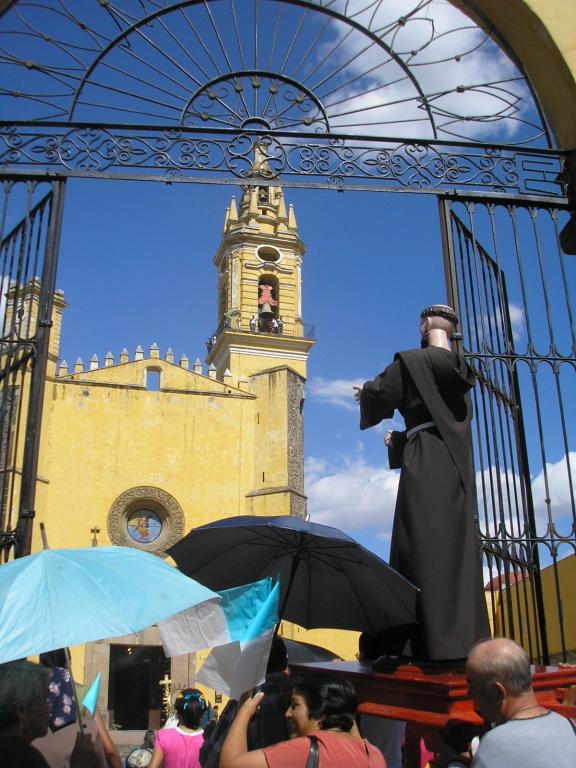
Townsend opens with the endearing bond between don Mateo Sánchez and fray Francisco de Toral, OFM, affectionately nicknamed Toraltzin (-tzin = a Nahuatl honorific suffix indicating respect and/or preciousness). Around the age of 13, Mateo and other native noble boys began studying Christian precepts, reading, writing, arithmetic, and art with Toral, learning to render their people’s pictorial Nahuatl – decipherable only to highly trained priests – into accessible alphabetic script. Highly educated by the standards of the time, these students came to consider themselves global indigenous Christians. Mateo and Toral would maintain their friendship through a devastating epidemic in 1545, Mateo’s rise as a leader in native government, and Toral’s promotion to Provincial in Mexico City, then to bishop in Yucatan. Inspired by his new knowledge, Mateo penned the Annals of Tecamachalco, his xiuhpohualli (SHOO-po-wa-lee; year-count, i.e., traditional Nahuatl-language written and performed history); for the year 1571 he included the words of various individuals who honored Toraltzin upon his death. Bereft of his ally, Mateo, a native governor, struggled in his dealings with the Spaniards; 9 years after losing Toraltzin he took to his bed and soon died. The pair would reunite in the land of Heaven.
Townsend similarly details the intellectual exchange between Pedro de San Buenaventura, one of the famous “trilinguals,” a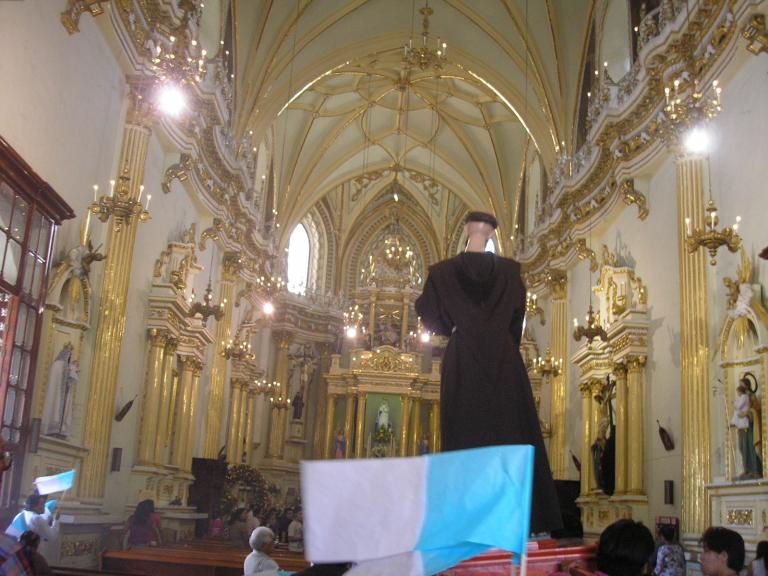 nd fray Bernardino de Sahagún, OFM, who trained him at the Franciscan Colegio de Santa Cruz to write in Spanish, Latin, and Nahuatl. Encouraged by his Provincial, fray Francisco de Toral, OFM (Toraltzin), Sahagún prepared his well-known Florentine Codex, a 12-volume compendium of Nahua culture, with the assistance of four indigenous aides, one of whom was San Buenaventura. Working through notes on his own, Sahagún consulted with San Buenaventura via Nahuatl-language letters that evidence their affectionate friendship. Like Mateo, San Buenaventura used his Franciscan education to influence, if not author, a Nahuatl-language history, Annals of Cuauhtitlan.
nd fray Bernardino de Sahagún, OFM, who trained him at the Franciscan Colegio de Santa Cruz to write in Spanish, Latin, and Nahuatl. Encouraged by his Provincial, fray Francisco de Toral, OFM (Toraltzin), Sahagún prepared his well-known Florentine Codex, a 12-volume compendium of Nahua culture, with the assistance of four indigenous aides, one of whom was San Buenaventura. Working through notes on his own, Sahagún consulted with San Buenaventura via Nahuatl-language letters that evidence their affectionate friendship. Like Mateo, San Buenaventura used his Franciscan education to influence, if not author, a Nahuatl-language history, Annals of Cuauhtitlan.
The next time we hear someone limit the legacy of St. Francis to the patron saint of animals and environmentalism, may we recall that in Mexico, his legacy amounts to the production and retention of indigenous memory. While true that Sahagún and other friars recorded indigenous culture and religion in order to eradicate it, Franciscan training nonetheless produced global indigenous Christians who in turn produced Nahuatl-language histories in alphabetic script. This is but one example of how native peoples in colonial Mexico were more involved in shaping their own experience than many people realize. Another native lord trained at the Franciscan Colegio de Santa Cruz, don Antonio Valeriano, for example, would successfully oversee the construction of an aqueduct to bring freshwater to Mexico City in 1582 after two Spanish attempts failed. That, perhaps, is the subject of another post.
The images are from a Marian feast day procession in 2009 of St. Francis carried into the 16th century church of San Gabriel in Cholula, Mexico. The stones of the Quetzalcoatl Temple are clearly visible on the unpainted side of the church.




